
"Floody Hell "
by Steve Williams
back
As I write
this the rivers through out the country are starting to rise with lovely
brown worm water.Ideal
conditions for Barbel.But itís
surprising how many fishermen find these conditions too daunting. What
you are about to read is the way I tackle a flooded middle Severn.
Living
in Bridgnorth helps me to keep an eye on what's happening, but even if you
don't live close enough to watch the conditions change you can still plan
your visit well by watching the weather reports and the reading the river
reports section on BFW. What you
are looking for is worm south westerly and a dropping barometric pressure,
that will undoubtedly bring in wet weather.The next
thing is to time your visit to coincide with the level topping out and starting
to drop.It takes
about 3 days for heavy rain in Mid and North Wales to
take effect on the middle Severn.I
am lucky, I can fish the river on the rise, topping out and falling, to pinpoint
when they feed best.
The Barbel
will feed in all the conditions, but the rise can sometimes cause you problems
with debris in the water catching on the line.One way to
help with rubbish on the line is to tie a stop knot 2-3ft above your
lead. This will catch a lot of the leaves and twigs etc, another is to
fish behind a sunken bush or tree, which will help to"filter out" some
of the rubbish.
One of the
most simple, and most important pieces of advice I can offer
to anyone thinking of fishing a flooded river, is to get to know the
stretch you are planning to fish before the floods.There
is very little point just turning up on a stretch of river and casting
out blind. 10 ft of colored water can easily cover a bush, small tree
or rocks and you wonít know until itís too late.I have
photos of the stretches of river I fish, taken in the Summer, showing
all the swims that I feel could be fishable during the flood.
The
photos show anything that could cause me problems once the river
rises, like
boulders and concrete blocks, bushes/ root's scaffolding etc.I
even visit the stretch and remove anything that I can that might
cause me problems at a later date.
(See pictures 1127, 1131,
1132 below)
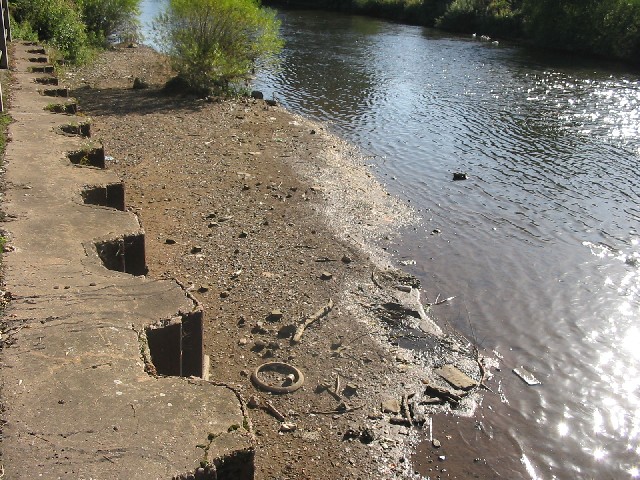
Picture 1127
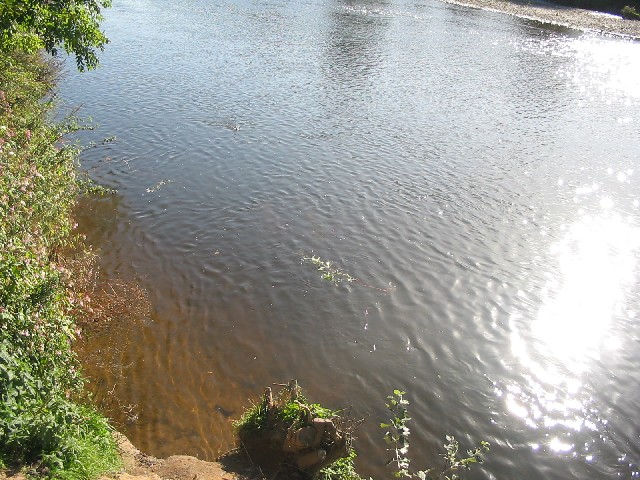
Picture 1131
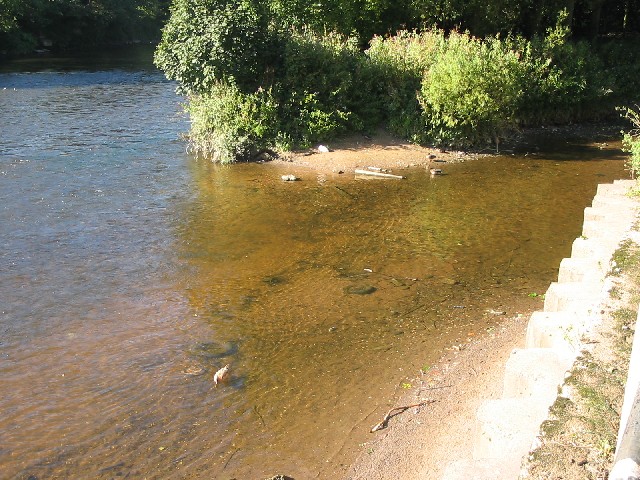
Picture 1132
If
I have a problem with snagging up, I can simply check the picture when I get
home and see if there is anything showing on them, if there is, I can
alter the position I cast to next time, or if nothing shows up on the
photograph I will leave the swim till I can check it in low water
conditions. No point risking loosing fish on a new snag, when there are plenty
more swims to fish.
The sort of
swims I am looking for are areas of smooth water, boils indicate an obstruction
or uneven bottom, never good to have an uneven bottom.
(See pictures 1892 and 1120
below)

Picture 1892
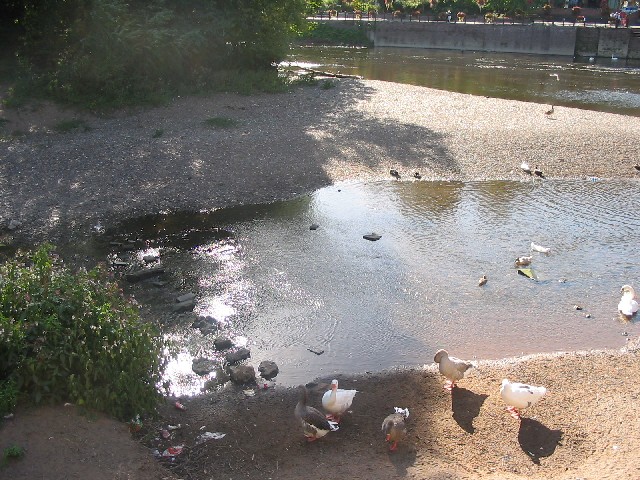
Picture 1120
Some of the
best swims are areas that in normal summer conditions
are dry land, or only have a couple of inches of water
over gravel/sandy bottom.Ideally,
you don't want to be casting far, just a gentle lob
out is enough, so the areas need to be close to the
bank. One
swim that has regularly produced fish for me is an
area where anglers sit in the Summer months and fish
from. (see picture 1130 below), but
during a flood a willow bush just upstream breaks the current and gives a lovely
glide/crease type swim.
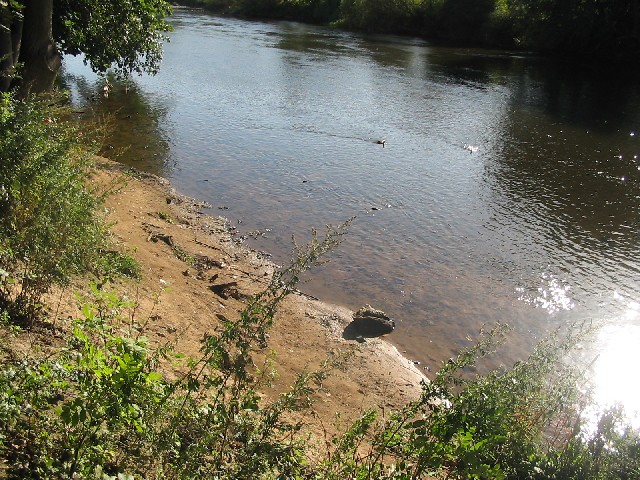
Picture 1130
I normally
rove down-stream, giving each swim 15-20
minutes, which will normally be a couple of casts,
if no bites materialize will move on, which will
mean that two free offerings will have been struck
off the hook and the swim pre-baited for when I
then rove
back up-stream later on, returning to the swims
in which I have either had fish/bites from, or
I just fancy another go in.I can
in good conditions, by which I mean 4-5 ft minimum
and anything up to 15-18 ft on, I can catch 6
or more fish in a couple of hours fishing, I think
my best session produced 13 fish in about 4 hours.Because
the river is up and colored, fishing in the dark
isnít
required, but I do feel that the fish are easier
to catch during the night, so if you are aloud,
try it, but it isnít necessary.
Rigs are kept simple, hook length is normally a
coated braid of some kind, of which I don't strip
back, I find this stiffness helps reduce tangles,
tied with
a large strong hook on one end, and a loop
on the other, fastened to a strong swivel. The
lead is attached via a snap link, so I can change
it if I need to, with a bead on the line below
the snaplink to help cushion and protect the
knot.
My
rod is a 2lb test curve Ron Thompson Barbel
rod, as I
tend to hold the rod and touch ledger,
quiver tips aren't needed.Leads
tend to be between 2oz-4oz Grippers or flat leads
to help hold bottom, and an Okumer reel (it has
a bait runner facility, but I only use it when
I put the rod down to pour a drink or answer
the phone).
Line is anything of the 10-15 lb breaking strain bracket,
that you have confidence in.And a small
bag containing a few bits and bob's, plus
maybe a flask/camera/scales etc.
Bait is
easy for me. Meat rules supreme. I'm
not too bothered about which brand, but
the more you pay the less fat is included, so,
as fat is buoyant, the more expensive ones
tend to sink better. I tend
to burry the hook due to the leaf's etc
that can catch on an exposed hook, and
the fact that sometimes the lead will shift
across the river bed and snag. The
middle Severn Barbel love meat, but they
can become a bit wary of cubes of meat
so one little dodge I
use is to make a meat paste. It's
simple to make...........Liquidize
two tins of meat, one at a time into
as smaller pieces as possible (use a
course cheese grater if "she
who must be obeyed" wont let you
near the one in the kitchen), and
place the mix
into a large mixing bowl. Boil
the kettle, and place a large heaped
teaspoon full of either Marmite or Bovril
into a mug and fill the mug with the
boiling water.Dissolve
the Bovril/Marmite into the water and
pour this over the meat. Mix
it into a sloppy mush then add pure brown
crumb to the mix, until a nice firm paste
is formed. I
then, with a knotless knot, hair-rig
a cork ball to a size 6 or 4 strong hook
tied to my braided hook length. I
mould the meat paste around both the
cork and the hook, so by giving the past
something to bind to (you can just mould
it around the hook itself if casting
isn't required), and if or when the paste
either falls of or is struck off to re
cast the cork raises the hook up off
the bottom and away from and snag's.
One
last point, SAFETY. 10
ft of foaming flood water will show
no mercy, do not put your self at risk
for a fish. There is only one way you
will be going if you slip in and that's
Digles weir. Unfortunately,
it happens every year. Please be careful.
Middle Severn flood water Barbel fishing isn't about big fish,
yes they are there, bigger than most
realize. It
is about the joy of catching small
to medium sized fish,
from swims that most anglers
think are un-fishable, in conditions
that most think are not worthy
of a few hours and a couple of
tins of meat, but you know different,
don't you, or just ask these too.
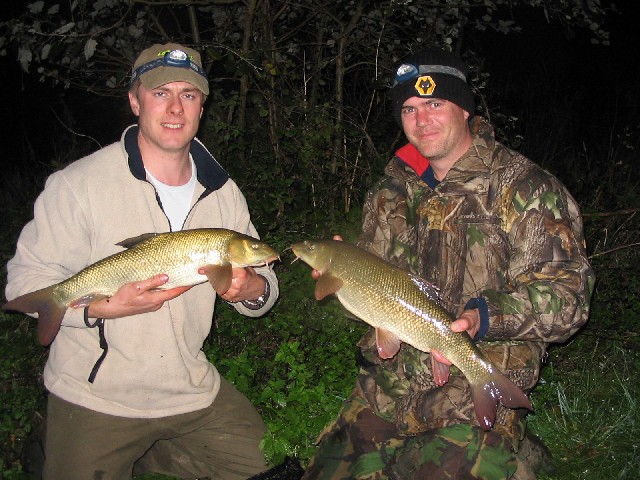
Picture 1897
(left Kris Price & right Martyn Lloyd)
I
am at the moment spending a lot of
time on the Lower Severn, trying
to get to grips with the fishing
there during a flood.There
are many difficulties to overcome,
but as I start to
sort out a few of the problems,
I will write a part 2 on lower Severn flood
water fishing.
Steve
Williams
October 2005
back


